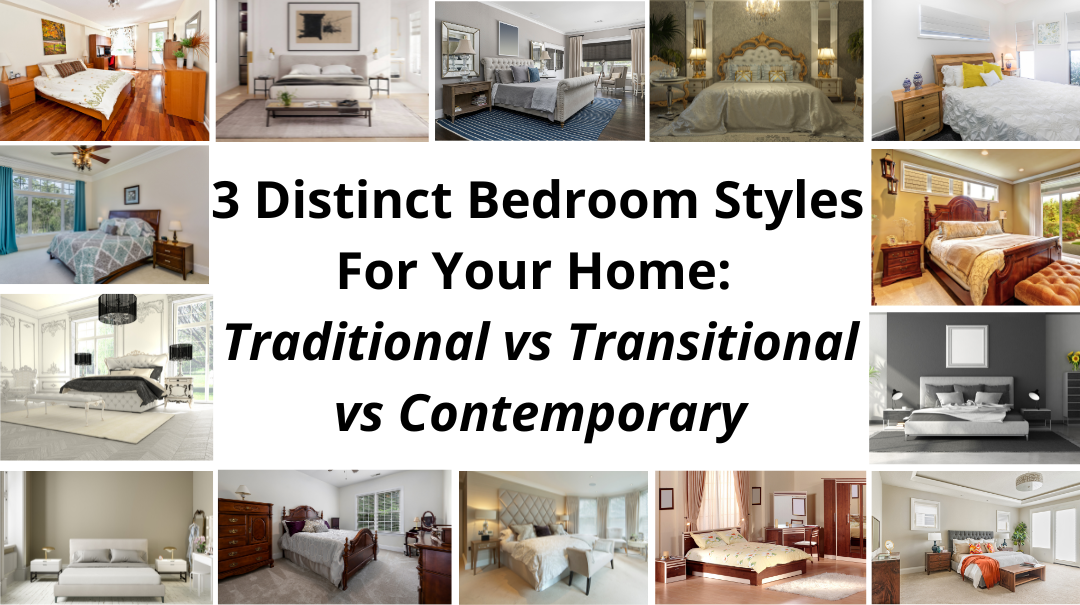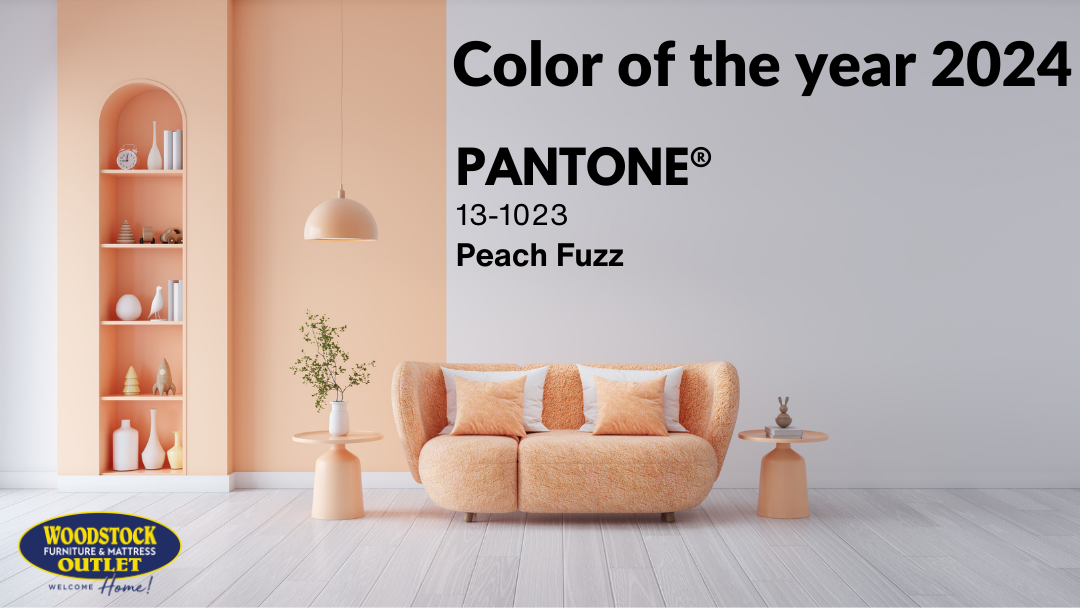A number of folks on our team have interior design education and/or decorating experience. However, the truth is that not all of us can be designers or decorators. As a result, keeping up with every new decorating trend can be difficult.
With more and more niche décor styles being invented seemingly every day, we usually try to keep it simple for our customers and empower them to take it from there. That’s why we like to boil things down to “The Big 3” timeless, essential, decorating styles. What are they, you ask? The truth is, you probably already know them – Traditional, Transitional and Contemporary.
In the past, we’ve talked in detail about what makes different pieces traditional, transitional, or contemporary / modern. Whether they be an area rug, a piece of upholstery, a living room, or a dining room. You don’t think we’d forget about the bedroom, do you? It’s only the most personal, intimate, sanctuary in your home. Shouldn’t it reflect your style?
What features make a bedroom contemporary? What makes bedroom furniture traditional? How do you update a traditional bedroom into something more transitional? What’s the difference between these three, anyway? We’re glad you asked! Read on for our brief discussion on contemporary, transitional and traditional styles in the bedroom, and the features that define them.

Traditional Bedroom vs Transitional Bedroom vs Contemporary Bedroom: What Are They & What Features Do They Have?
Each of us have our own “personal brand” formed by the things we like and how we like to be perceived by others. Our individual tastes and the decisions based on them impact everything from the music we like and the entertainment we consume, to the hobbies we pursue, to the clothes we wear, to the furniture in our bedrooms.
As a part of this, most of us have our own array of unique, stylistic preferences. Are yours whimsical or straight-to-business? Is your go-to style casual and laid-back, or formal and sophisticated? For most of us, this is a subconscious part of who we are. We like what we like, right? But have you ever consciously stopped to consider what your own personal style is? [Editor’s Note: If not, you should check out our free style quiz, but let’s circle back to that later!]
Regardless of what your sense of style is, your bedroom shouldn’t just be some place where you sleep. On the contrary, your bedroom should be a comforting space in your home that truly reflects you. Your bedroom’s décor isn’t only for show, and it’s not merely for the approval of guests. This arguably makes the bedroom the most important space in the whole home.
To take the first steps towards figuring out which bedroom style is right for you, we need to define Traditional Bedrooms, Transitional Bedrooms, and Contemporary Bedrooms, and explore their features. Let’s go!
What Is a Traditional Bedroom?
Traditional style is classic and timeless, and the traditional bedroom is no different. This style is inspired by a broad collection of style sub-categories that can trace their origins to a few decades ago, or a few centuries ago. For some very diverse examples, rustic farmhouse, American colonial, Victorian, cottage, and even newer revival styles like grandmillennial and Bohemian / Boho chic, are largely considered to be traditional.
Traditional styles can take a couple different forms. Some of these traditional bedroom styles are simple and practical, while others are ornate and decorative. One traditional bedroom could prominently feature an ornate Victorian canopy bed, while another could have a Shaker-style or Amish solid wood farmhouse bed with matching dresser or chest. Both are traditional, but they couldn’t be more different.
The key here is that traditional bedroom styles must come from an established design history. If you have an appreciation for history, vintage aesthetics, antiques, or time-honored traditions, a traditional bedroom set is likely a great fit.
What Features Make a Bedroom Set Traditional?
So, exactly what makes a bedroom set traditional? As we discussed above, traditional bedroom furniture can be either casual or formal, so the features can vary somewhat. However, there are several consistent characteristics. To clarify, some of the features below can be seen in transitional style also, but they generally indicate a traditional style.
Let’s start from the ground and work our way up. Any time you see turned legs or bun feet, that is a probable indicator of traditional design. If a nightstand or bedside table has turned legs, a poster bed has turned legs or posts, or a dresser, chest or other piece of bedroom furniture has bun feet, these are all clues that point to traditional style.
This is because traditional design prominently features curved lines. A great example of this in bedroom furniture is the “waterfall edge”. However, even more subdued traditional pieces like those in the Amish style will still have some curved lines or rounded edges. Needless to say, any kind of ornate carvings or curved edges also lend themselves to traditional design whether on the furniture legs, table tops, or elsewhere.
The final and maybe the most-telling sign of traditional bedroom furniture is the wood or finish. Particularly dark woods and rich finishes are another sign of a traditional bedroom set. Especially woods like mahogany, walnut or cherry.
What Is a Transitional Bedroom? (Alternatively, How Do You Update a Traditional Bedroom?)
By contrast, Transitional Bedrooms feature a mix between traditional styles and more modern/contemporary styles. Most often, shoppers looking for transitional styles may not know exactly how to describe what they’re looking for. For instance, these shoppers will often ask questions like “How to update a traditional bedroom?”. But what they’re really trying to describe is transitional style.
Typically, transitional pieces take an established traditional style and update, deconstruct, or reinterpret it to make something that feels new, yet familiar. Arguably the best part of Transitional Bedrooms is that unlike their traditional and contemporary counterparts, they are much less concerned with rules, assumptions, or stylistic conventions. If you’re a little bit unconventional, maybe your bedroom should be that way too!
For some good examples of eclectic, transitional style, look no further than modern farmhouse, coastal, casual, rustic, or industrial chic. These looks are great for those who want to respect the legacy of the past while looking hopefully towards the future.
What Features Make a Bedroom Set Transitional?
Whether you’re redecorating a traditional bedroom and looking for an update, or starting over from scratch, how does one take a traditional aesthetic and make it transitional? This is most easily done by trading a traditional color palette (typically darker wood finishes) to something neutral or monochromatic. This is most often varying shades white, gray, or taupe, although lighter wood tones are common too. This holds true for literally every room in the home.
Any upholstery or other fabric in your bedroom (such as a bedspread, pillows, comforter or quilt set) should also be in similarly muted shades, and you should avoid overly loud, or busy designs. Remember how traditional design can be very curvy, bold, floral and ornate? At a bare minimum, we want to downplay that a bit.
Lastly, transitional bedroom furniture often keeps the overall form of traditional furniture, but with curved pieces replaced with angled, polygonal ones. Where you may have the same wood construction as a traditional piece, the shapes and angles may be more reminiscent of contemporary styles. For instance, a transitional interpretation of an otherwise very traditional poster bed may involve replacing spindle or turned legs / posts with rectangular ones. Similarly, decorative rounded edges may be replaced with less-ornate square, tapered or beveled edges.
What Is a Modern or Contemporary Bedroom?
Lastly, we come to the Contemporary Bedroom and with it, contemporary style (alternatively known as on-trend or modern). Unlike established traditional styles, contemporary styles are constantly changing. However, in recent times, contemporary styling has continued to refer to minimalist, sleek, and streamlined looks.
Since the mid 20th century, many décor and design styles grew and flourished that we still consider contemporary to this day. Contemporary design includes long-established styles like Scandinavian and mid-century modern, but also much more recent style trends like rustic modern.
Do you want a functional, practical, or even minimalist bedroom with a forward-looking style? Something with a forward-looking style and without unnecessary or gaudy decorations? A Contemporary Bedroom might be perfect for you.
What Features Make a Bedroom Set Contemporary or Modern?
Finally, of the big 3 styles, contemporary bedroom furniture is usually the easiest to spot. This is for several reasons.
First, be on the lookout for mixed material construction. What do we mean by this? Well, traditional (and most transitional) furniture is typically made from wood, whether solid wood or wood veneer. Mixed materials means that you may have other atypical construction materials involved, whether they be metal, glass, granite, sturdy plastics, or something else. This is an obvious sign of contemporary design.
The other telltale sign of contemporary bedroom furniture (or any contemporary furniture for that matter) is the presence of clean, straight lines and sharply-angled corners throughout the room. For a good example, imagine a stereotypically low-profile platform bed. If a bedroom set has a lot of straight lines and right angles, squared feet, or even the absence of legs/feet entirely, you’re looking at a more contemporary design scheme.
Although colors within contemporary design can vary, minimalism is still a key component. Loud patterns and colors should be used sparingly as accents.
Which of These 3 Styles Is Right for Your Bedroom? Take Our Free Décor Style Quiz to Find Out!
So, which of these styles feels right for your bedroom? Now that you’ve learned about the big 3 décor styles and how they relate to bedroom furniture, you should have a better idea which style is the best fit for the bedrooms in your home.
Whether you’re looking for an entire bedroom set, a bed or headboard, chest or dresser, nightstand or vanity, we’re confident that we have something you’ll love! We have a wide variety of traditional, transitional and contemporary bedroom furniture available. Come see a selection of our bedroom furniture online or at our 3 metro Atlanta and North Georgia furniture stores!
By the way, have you taken the free décor style quiz on our website? Now that you’re all read up on décor styles, be sure to head over to our homepage and take the quiz! Just look for the link on the right margin as you browse.
[Editor’s Note: For similar décor advice on dining rooms, living rooms, upholstered seating, and area rugs, don’t miss our article on Traditional, Transitional & Contemporary dining rooms, our comparison of Traditional, Transitional & Contemporary Rugs, or our piece on Contemporary vs Transitional vs Traditional upholstery styles!]


















